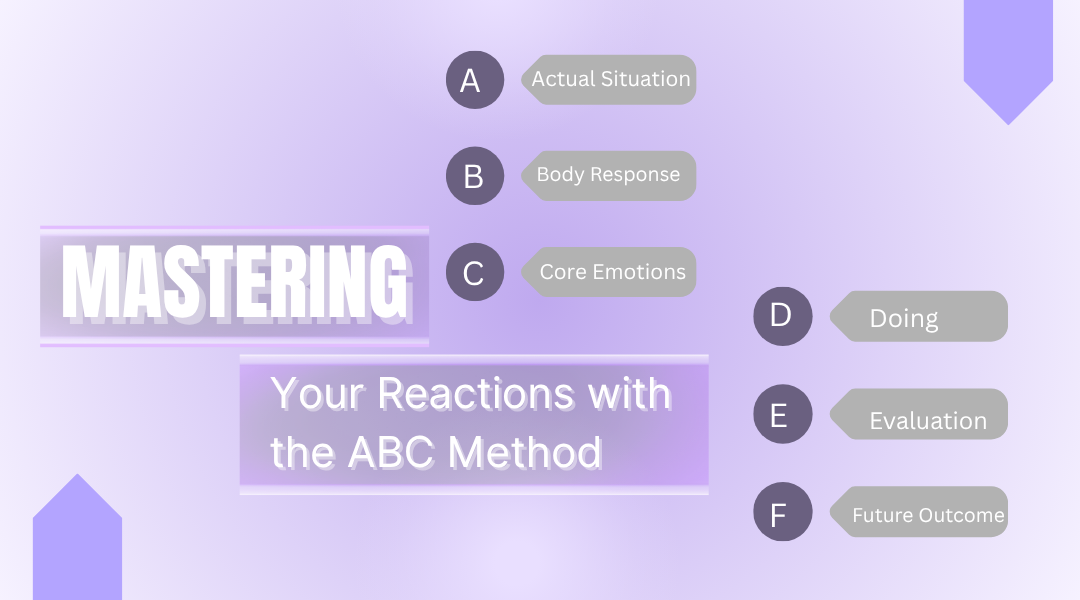Break Down Your Thoughts to Take Back Control
When stress or anxiety hits, it’s easy to spiral into worst-case scenarios. Emotions flare, thoughts race, and suddenly, you’re drowning in overwhelm without even knowing why. The key? Slow down and untangle what’s really going on in your head and body.
One of the best ways to do this is with the ABC method—a simple but powerful way to dissect your reactions, understand your triggers, and regain control. Instead of letting emotions run the show, this approach helps you pause, analyze, and respond with clarity.
How the ABC Method Works
This technique breaks down any stressful moment into clear parts, making it easier to see how they connect and influence each other.
A — Actual Situation (What Happened?)
Start with the facts. What actually triggered your reaction? Stick to the bare details—no interpretations or emotions yet.
Example: “My boss just handed me a last-minute project due tomorrow.”
Keeping it objective cuts through the mental fog that anxiety loves to create.
B — Body Response (How Did You Feel Physically?)
Your body reacts before your brain catches up. Those physical sensations? They’re your early warning system.
Example: Your chest tightens, your stomach knots, or your hands get clammy.
Noticing these signs helps you recognize stress before it takes over.
C — Core Emotions (What Did You Feel Inside?)
Once your body reacts, emotions flood in. They might hit hard and fast, but naming them takes away some of their power.
Example: Panic, frustration, or even dread after seeing that unexpected deadline.
Putting a label on your emotions makes them easier to manage.
D — Doing (How Did You React?)
This is where actions come in. What did you do in response to those feelings?
Example: You procrastinated, scrolling through your phone instead of starting the project.
Sometimes, our reactions are just quick fixes to avoid discomfort—but they don’t solve the problem.
E — Evaluation (What Were You Thinking?)
Now, dig into the thoughts running through your mind. These are usually assumptions, not truths.
Example: “I’m going to fail,” or “I can’t handle this.”
When you write them down, you can challenge them. Are they really facts, or just fear talking?
F — Future Outcome (What Did You Wish Would Happen?)
Finally, what were you hoping for in that moment?
Example: Wishing the deadline would disappear or that someone else would take over.
This step reveals what you were really avoiding—whether it was fear of failure, pressure, or feeling unprepared.
Real-Life Example: Public Speaking Nerves
Let’s say you’ve been asked to give a presentation. Here’s how the ABC method plays out:
- A (Trigger): “My team lead assigned me to present our project next week.”
- B (Body): Heart racing, palms sweating.
- C (Emotion): Fear, self-doubt.
- D (Action): Avoiding practice, distracting yourself with other tasks.
- E (Thoughts): “I’ll embarrass myself,” or “Everyone will think I’m unprepared.”
- F (Desire): Wishing someone else would do it or the meeting would get canceled.
Seeing it all laid out makes it easier to challenge those thoughts. Maybe you’ve presented before and survived. Maybe preparation will ease the nerves. The point is—you’re no longer on autopilot.
Why This Works
The ABC method forces you to step back instead of getting swept up in emotions. When you break a reaction into pieces, you see what’s really driving it. Over time, this builds emotional awareness—so you respond with intention, not just impulse.
Bottom line: When you understand what’s happening inside, you control how you handle it.
Next time stress takes over, try the ABC method. Write it down, dissect it, and watch how much power you gain back.
